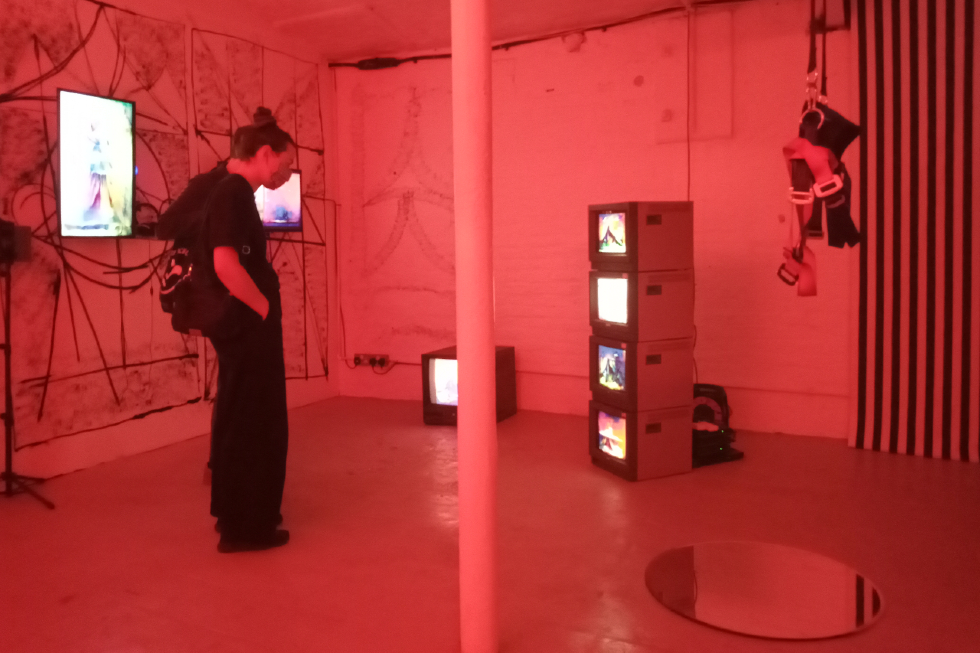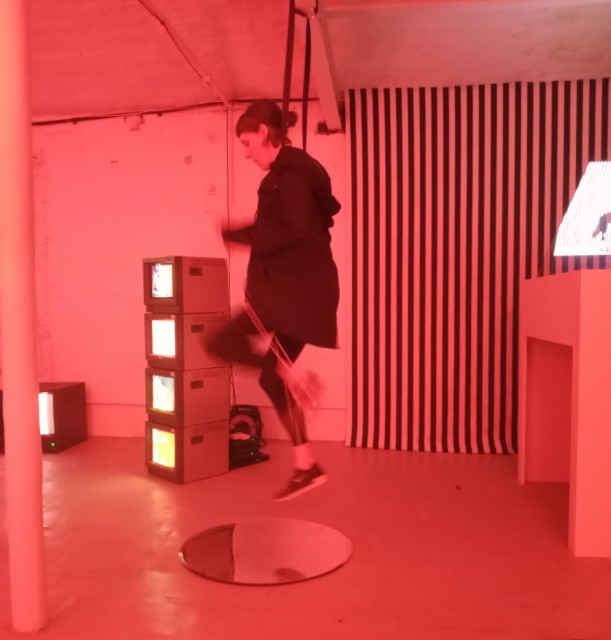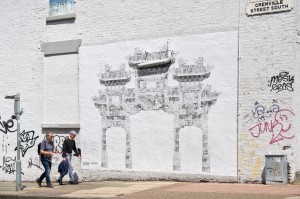On the Threshold – PROFORMA X Begehungen: Leerzeit

How have you spent your time during the last 18 months or so? Mike Pinnington reports on an exhibition scrutinising, appropriately, Leerzeit, the German term for Idle Time…
The room glows red. It’s not the red of a warm embrace; nor, however, is it a warning signal; or one of seduction. Flooding the relatively small space, its effect is closer to a kind of membrane, providing the conditions for passage between here and there. There being Begehungen Festival in Chemnitz, Germany, and here, Salford. After adapting to the red neon, your eyes pan the room. On the floor is a circular mirror – or, maybe more accurately, we should think of it as a portal, representing the threshold to eastern Germany. What – or who – would we find on the other side were we to pass through it? Suspended from the ceiling above, peddling intently, is artist Nicola Dale. If you close your eyes, the red still throbbing through them, it’s very easy to imagine a double on the other side of that mirror; Dale and her doppelgänger in lockstep, rhythmically moving in space.
This is It Is Solved By Walking, one of a pair of new pieces made by Dale during her four week residency at PROFORMA, Islington Mill. Like an in real life Eadweard Muybridge’s human figures in motion, watching the artist’s repetitive movement lulls you, mesmerised. For ten minutes, we stare at Dale, marvelling at the physical endeavour, at the energy expended and calories burned as she goes literally nowhere. Beyond this prosaic act of endurance, the mind wanders, even if the body does not, to the imaginary journey that could be going on in Dale’s mind. Where might she be walking and what problem is she trying to solve? Does she imagine herself transported to the old industrial railroad into Chemnitz, a secular pilgrimage down disused tracks? Or is she treading once more the many endless lockdown trudges to nowhere and back that perhaps informed the work? Maybe the point is to turn such questions on oneself, letting the mind take a walk, while Dale (thankfully) does the legwork.
Adjacent is Strike. Employing the 19th century illusion technique Pepper’s Ghost (so named for scientist John Henry Pepper, the man responsible for popularising it), we see a spectral holographic Dale act out, or ‘strike’, twelve playful poses – one for every hour in the day – over a sixty-minute period. As with It is Solved By Walking, it’s a short step to imagining yourself in the artist’s shoes, straining to put and keep the body in position. Harder than you think; harder than it looks. Each work gives shape and space to time spent, supposedly, doing nothing. In the accompanying exhibition text, Dale ponders how we relate to time as a construct, what it represents and where we’d be without it: “It shifts and it’s greedy”; it is “A feeling not a structure”; and, most hopeful yet daunting of all: “it can never end”, no matter how it is marked or spent. All of which chimes closely with PROFORMA X Begehungen’s subtitle, Leerzeit, loosely translated from the German as ‘idle time’. The term – on the face of it straightforward – is fraught with ambiguous meaning and dualities. Given these last eighteen months or so of time behaving and being used differently (but rarely, in truth, idly), it is something we can all identify with.

The relationship between Dale’s bodily performance-based works and those of fellow residency artist Parham Ghalamdar is, at least initially, unclear. After dwelling in the analogue world, eyes and brain scramble to adapt to read new, digital information, in search of meaning. Ironically displayed in-part on ancient-looking monitors, the seven separate but related works (AI Generated Painting No1 – No7) swirl and evolve; the effect is hypnotic – colour and texture bleeding together to produce a strange, abstracted frisson of unmooring. Not unlike the one bequeathed us by COVID-19 and its fallout. Aptly, says Ghalamdar, these are his exploration of “the relationship between painting and the digital within the context of lockdown.”
Wrestling with the new set of circumstances, he’d needed to negotiate his practice: “In the absence of the studio, audience, gallery, and a physical art scene,” he’d turned to an expanded reading of painting. His first act was to feed an AI with images; in turn, the AI found patterns in those images, and created varieties, “slightly deviating the style” of the ‘originals’. Once you absorb this information, and consider the context for the images’ genesis, it makes the looking all the more fascinating. The AI’s muddying of the artist’s presence – removing brush strokes and softening marks into oblivion – adds yet another layer to the old adage about the duplicity, or treachery of paintings. It’s an interesting place to get lost. Ghalamdar’s works pose questions of authorship and reception, in doing so reconnecting us with – and forcing us to reassess – those many months of physical absence and restricted movement; how many of us hungrily consumed online exhibitions only to ponder how different, more ‘authentic’ they all would have been had we seen them IRL.
Subjectively speaking, being in a physical space with artworks and people is by far my preferred method of reception; it just feels more like how it should be, right? Of course, it’s not exactly the same, not just yet – in this room, for instance, we’re all wearing masks, awkwardly fist- or elbow-bumping. But Leerzeit – unafraid to reference the recent past and uncertain present into which we continue to emerge – at least points the way forwards. Dale and Ghalamdar’s works hint at how we all occupy a somewhat liminal, unfixed reality now – it’s the same but different, this not quite ‘normal’ in which we find ourselves. But it reminds us that we are present and active rather than passively, idly scrolling; that we are alive rather than simply existing.
Mike Pinnington
Home page image courtesy Chris Bailkoski





